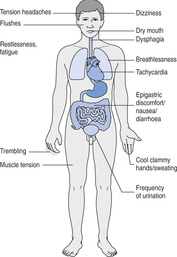AGORAPHOBIA
Clinical features
Agoraphobia consists of a cluster of anxiety-causing phobias which embraces fears of leaving home (e.g. fear of entering shops), crowds, public places and travelling alone on public transport. These cause the patient to become housebound. The lack of an immediately available exit is a feature of many of these agoraphobic situations (ICD-10).
Epidemiology
Age of onset
Variable, but often starts in the 20s or 30s.
Sex ratio
More common in females.
Management
The treatment of choice is behaviour therapy, involving exposure combined with anxiety management. Short-term anxiolytics and antidepressants for any associated depressive symptoms may be considered: monoamine oxidase inhibitors (MAOIs) and reversible inhibitors of monoamine oxidase type A (RIMAs) may be particularly helpful.
Prognosis
In the absence of effective treatment agoraphobia typically persists for years, though usually fluctuating.
SOCIAL PHOBIA
Clinical features
The phobias centre as a fear of scrutiny by other people in comparatively small groups (as opposed to crowds), leading to an avoidance of social situations, such as eating in public, public speaking and encounters with the opposite sex (ICD-10).
Epidemiology
Age of onset
Often begins in adolescence.
Sex ratio
Equal.
Management
The treatment of choice is behaviour therapy, involving exposure combined with anxiety management.
Prognosis
It is usually chronic if untreated and may be exacerbated if performance in the social phobic situations is worsened because of anxiety.
SPECIFIC (ISOLATED) PHOBIA
Clinical features
The phobias are restricted to highly specific situations, e.g. proximity to animals, heights, thunder, darkness, flying, closed spaces, eating certain foods, dentistry and the fear of exposure to specific diseases such as AIDS and radiation sickness (ICD-10). Contact with the triggering situation may lead to panic.
Epidemiology
Age of onset
Usually starts in childhood or early adult life.
Management
The treatment of choice is behaviour therapy, involving exposure combined with anxiety management.
Prognosis
In the absence of effective treatment specific phobias can persist for years.
PANIC DISORDER
Clinical features
There are recurrent attacks of severe anxiety (panic), which are not restricted to any particular situation and are therefore unpredictable (ICD-10). Symptoms include a sudden onset of palpitations, chest pain, choking, dizziness, sweating, trembling, depersonalization or derealization, and a secondary fear of dying, going mad or losing control. Attacks tend to last for only a few minutes but during them the anxiety and autonomic symptoms build up quickly, often leading to a hurried exit from where the patient is.
Exclude organic causes such as hypoglycaemic episodes, hyperthyroidism and phaeochromocytoma. Panic disorder may be secondary to depressive episodes.
Management
Supportive measures
The patient should be reassured and the causes of individual symptoms, e.g. palpitations, should be given to allay unnecessary worry.
Drug treatment
Antidepressants (e.g. imipramine) are effective in treating panic disorder, whether or not there is an underlying depressive disorder. Anxiolytics, including buspirone and benzodiazepines, can be used for the short-term management of anxiety disorders.
Cognitive therapy
In patients worried about physical consequences of anxiety symptoms, e.g. that palpitations are related to heart disease, the symptoms are induced voluntarily, e.g. by hyperventilation or exercise, and their nature is explained.
GENERALIZED ANXIETY DISORDER
Clinical features
Generalized and persistent anxiety that is not restricted to, or even strongly predominating in, any particular environmental situation, i.e. it is free-floating (ICD-10). Symptoms can result from sympathetic overactivity, increased muscle tension and hyperventilation (Fig. 7.1) and commonly include a continuous feeling of nervousness, trembling, muscular tension, sweating, light-headedness, palpitations, dizziness, dry mouth, epigastric discomfort and increased frequency and urgency of micturition. Sleep disturbance may occur, typically with initial insomnia while the patient lies in bed worrying, and broken sleep thereafter.
 |
| Figure 7.1 (With permission from Puri BK, Laking PJ, Treasaden IH 2002 Textbook of psychiatry. Churchill Livingstone, Edinburgh.) |
Epidemiology
Sex ratio
More common in females.
Stay updated, free articles. Join our Telegram channel

Full access? Get Clinical Tree







